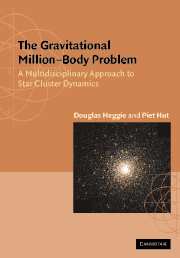Book contents
- Frontmatter
- Contents
- Preface
- PART I INTRODUCTIONS
- PART II THE CONTINUUM LIMIT: N → ∞
- PART III MEAN FIELD DYNAMICS: N = 106
- PART IV MICROPHYSICS: N = 2
- PART V GRAVOTHERMODYNAMICS: N = 106
- PART VI GRAVITATIONAL SCATTERING: N = 3
- PART VII PRIMORDIAL BINARIES: N = 4
- PART VIII POST-COLLAPSE EVOLUTION: N = 106
- PART IX STAR CLUSTER ECOLOGY
- Appendix A A Simple N-Body Integrator
- Appendix B Hints to Solution of Problems
- References
- Index
PART II - THE CONTINUUM LIMIT: N → ∞
Published online by Cambridge University Press: 05 June 2012
- Frontmatter
- Contents
- Preface
- PART I INTRODUCTIONS
- PART II THE CONTINUUM LIMIT: N → ∞
- PART III MEAN FIELD DYNAMICS: N = 106
- PART IV MICROPHYSICS: N = 2
- PART V GRAVOTHERMODYNAMICS: N = 106
- PART VI GRAVITATIONAL SCATTERING: N = 3
- PART VII PRIMORDIAL BINARIES: N = 4
- PART VIII POST-COLLAPSE EVOLUTION: N = 106
- PART IX STAR CLUSTER ECOLOGY
- Appendix A A Simple N-Body Integrator
- Appendix B Hints to Solution of Problems
- References
- Index
Summary
Even though this is a book about dense stellar systems (i.e. what is often called ‘collisional’ stellar dynamics, though no physical collisions need take place), it rests on a foundation of ‘collisionless’ stellar dynamics, and the relevant aspects are surveyed in these five chapters. In addition, we outline the various ways in which the effects of gravitational encounters can be incorporated, though the details are deferred to later sections of the book.
Chapter 5 begins with a discussion of the main aspects of the thermodynamic behaviour of N-body systems: how a stellar system responds to being put in contact with a ‘heat bath’, for instance. In fact, stellar systems tend to cool down if heat is added; paradoxical though this might seem, it helps us to understand even the motion of an Earth satellite. A toy model helps to explain what is happening.
Chapter 6 introduces the basic tools used for describing large numbers of gravitating particles: phase space, the distribution function f, the gravitational potential, and the equation governing the evolution of f (the ‘collisionless Boltzmann equation’). We outline some of its solutions, and aspects of the manner in which they evolve, especially phase mixing. We also look at the development of Jeans' instability.
For our purpose the most important distribution functions are those exhibiting spherical spatial symmetry. Therefore Chapter 7 is devoted to the motion of stars in spherical potentials, including constants of the motion and their link with symmetry.
- Type
- Chapter
- Information
- The Gravitational Million–Body ProblemA Multidisciplinary Approach to Star Cluster Dynamics, pp. 41 - 42Publisher: Cambridge University PressPrint publication year: 2003



